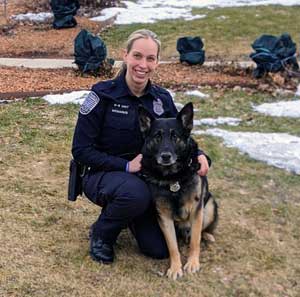 This article has been written with the assistance of Detective Holly McManus who is K-9 Handler with the St. Francis Police Department in Wisconsin. Her canine partner is a purebred German Shepherd who goes by the name K-9 Bane.
This article has been written with the assistance of Detective Holly McManus who is K-9 Handler with the St. Francis Police Department in Wisconsin. Her canine partner is a purebred German Shepherd who goes by the name K-9 Bane.
There are many different careers in law enforcement and a variety of law enforcement jobs available. One of the most sought after jobs is being in a K-9 unit. K-9 officers or K-9 handlers are essentially law enforcement officers who use their service dogs to perform the duties of a general police officer. In addition to their regular duties, K-9 handlers are also involved in training and caring for their canine partners. This makes both the officer and the dog partners not only at work but also at home.
In this article, you will gain an in-depth understanding of everything that the job of a K-9 entails and a valuable set of insights shared by a real-time, highly experienced K-9 handler.
What Does a Law Enforcement K-9 Handler Do?
K-9 officers are responsible for enforcing local, state, or federal laws depending on the agency that they work for, and they are a peace officer. Typically, their duties are based on the mission of the agency that they work for, the division within that agency that they are assigned to, and the skills of the dog.
 For instance, a dual purpose K-9 is specialized both in nose work for detection of narcotics or explosives and in bite work for protecting both the public and his handler. In this scenario one of the major purposes of the K-9 handler would be patrolling.
For instance, a dual purpose K-9 is specialized both in nose work for detection of narcotics or explosives and in bite work for protecting both the public and his handler. In this scenario one of the major purposes of the K-9 handler would be patrolling.
When it comes to a track and find or an area search, a K-9 handler paired with a cadaver dog would be utilized. Some of the larger agencies have bomb dogs assigned to the handlers who deal majorly with explosives. There are K-9 handlers with narcotics detecting dogs who are assigned to the jail.
A K-9 handler is required to train their dog to meet the needs of his department. The canine accompanies their handler on duty and assists them in a variety of tasks that include detecting illegal substances, explosive or chemicals, tracking and rescuing missing persons, and locating submerged or buried corpses or human parts.
Types of Agencies that Use K-9’s
Local, state, and federal law enforcement agencies have K-9 handlers with their K-9 partners. A few specific agencies that employ K-9’s include the US Drug Enforcement Agency, US Customs and Border Protections, US Secret Service, and the FBI.
When it comes to local agencies, the K-9 handlers train their patrol dogs to detect explosives or narcotics. A large number of these canines are also capable of physically capturing suspects by restraining them until officers can take them into custody. This is very beneficial in protecting their handler, other officers and well as the community.
The FBI includes high-risk Hostage Rescue Team (HRT) dogs. They team up with their respective officers and deal with SWAT call-ups and other high-risk calls. There are also K-9’s that are used for Internet Crimes Again Children (ICAC) investigations. These ICAC dogs can sniff out the components used in downloadable devices, such as jump drives, SD cards, and portable hard drives.
Types of Dogs Used in the K-9 Unit
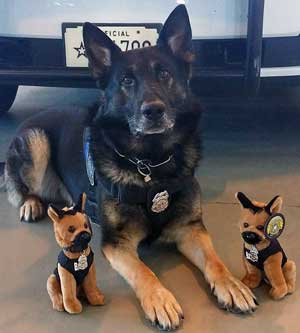 Agencies use a variety of different breeds of dogs, depending upon the mission for which they will be used. A few of the most common service dog breeds include German Shepherds, Belgian Malinois, Rottweilers, Bloodhounds, Doberman Pinschers, and Beagles. Agencies also use standard Labradors (yellow or black) for sniffing in search of narcotics or explosives.
Agencies use a variety of different breeds of dogs, depending upon the mission for which they will be used. A few of the most common service dog breeds include German Shepherds, Belgian Malinois, Rottweilers, Bloodhounds, Doberman Pinschers, and Beagles. Agencies also use standard Labradors (yellow or black) for sniffing in search of narcotics or explosives.
A dog’s incredible sense of smell enables you to train them to sniff for anything that you want them to. Following the current trend, agencies don’t spend $12,000 to $18,000 on purchasing a already trained police dog. Instead, agencies now often adopt dogs from shelters do their training themselves. This the reason you can now a wider wider of K-9 dogs being used.
Agencies also choose a K-9 dog based on its drive. It can be a mellow Labrador that can be presented to the public or a driven Belgian Malinois, that fits perfectly for SWAT resources. Overall, you can choose any dog to be a police K-9 because it can be tailored for the task on the basis of its personality and drive.
How to Move into the Position of a K-9 Handler
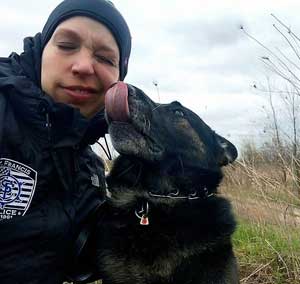
In order to apply for the position of a K-9 handler, you will need an application, a resume, and a fair amount of dedication considering how you will be entrusted with the dog throughout your career. You will have already met the police officer requirements when you joined the agency.
Generally, agencies do not consider the position of a K-9 handler to be entry-level. So when you are looking at police jobs, you most likely will not see these positions posted as open to the pubic. The officer must have a certain amount of experience before moving into this position. When entrusting a canine to the K-9 handler, the agency must be able to trust the individual with the liability the dog comes with, especially if the canine is trained as a dual purpose dog. This is the reason one must prove oneself as an officer before proving oneself as a K-9 handler.
A great way to learn more about this position is by being in contact with the experienced K-9’s and their handlers. See if you can go along with them for either a call or on a track. This gives you a live insight into how K-9 handlers perform their duties.
K-9 Handler’s Training

The most important elements that form a part of the K-9 handler’s training include dog obedience, crowd control, safety, tracking, and finally, how to take care of their dogs.
The K-9 officers take a certification course on canine behavior and first aid techniques. They also receive monthly training of 12-16 hours in addition to the duties they are assigned to. The goal here is to train the officer to be prepared to handle a variety of situations and interactions.
Each dog also undergoes special training in order to become a part of the K-9 unit. In order to qualify for the training, the dog has to pass through a series of temperament tests. Once it is established that the dog can adapt to different environments and fluctuating situations with ease and had the ability to chase, prey and defend, the dog is deemed fit for the duty.
Does a K-9 Have More than One Handler

However, over the years, this practice quickly evolved to focus on the bond between a K-9 and a K-9 handler. Today, this relationship forms an important aspect of the job position. The K-9 comes with a substantial amount of potential liability and it is the responsibility of the K-9 handler to properly control their K-9 partner.
A k-9 handler must be able to trust their dog. In fact, as time passes, the officer grows more attached to and experienced with their dog. This factor lets them have better control over what their K-9 partner does in a given situation.
What happens to K-9’s when Off-Duty
When off duty, the K-9 generally goes home with their handler because it is already a part of the handler’s family. Depending on the agencies, a majority of K-9 handlers are assigned their own squad cars or vehicles to transport the dog to and from the handler’s home.
Detective McManus has had a five-foot by five-foot enclosure in her basement for her K-9 partner Bane. However, because Bane and her have such a strong bond and she trusts him, he actually is integrated into her family at home. She has another dog, a family dog, and Bane is part of that family. That is becoming more common in today’s K-9 handling world because that bond with that dog is so important.” She remarks.
What Happens When a K-9 Retires
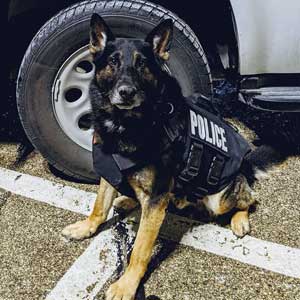
The contract the Detectus McManus has with the city as a K-9 handler, is that she will buy K-9 Bane for a dollar and then it will literally become a retired K-9 officer, much like how police officers become retired. His liability, care, vet bills, and everything else will them become the responsibility of Detective McManus personally. Right now, the city of St. Francis technically owns Bane and carries that liability for him.”
What Happens to the K-9 Handler When the K-9 Retires
For someone who is looking to become a K-9 handler, it is also important to understand what retirement for a K-9 handler looks like. In a few agencies, once a K-9 handler has performed their tour of duty with a specific dog for six to eight years (depending on the dog’s lifespan), they will no longer be a K-9 handler. In this scenario, the handler can then apply for a promotion and or get integrated back into patrol. In other agencies, the K-9 handler has the option to take on another K-9 after their K-9 partner retires.
Before taking the position of a K-9 handler, an officer needs to know what will happen when their dog retires, and whether they get to keep their K-9 handler position after their current K-9 partner retires. In agencies where the K-9 handler has the option of taking on another K-9 after theirs’ retires, some K-9 handlers have been known to have worked with over four dogs or more throughout the span of their career.
K-9 Handler Success Stories
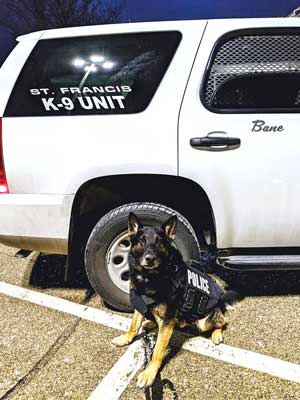
In a motorcycle theft case, Bane put his unfailing skills to use. The situation escalated when the suspects got in a car accident and fled in the opposite direction. Despite a witness pointing towards a specific direction, Bane took the other direction and tracked the suspect from the passenger seat of the car. The dog tracked the suspect into a marshy area a couple hundred feet away. Officers had to call the Department of Public Works to come in and use chainsaws and weed whackers in order to clear a path so officers could get into in. The suspect was about 75 to 100 feet into the thicket and was entirely inconspicuous. Bane somehow tracked the suspect and led officers right to where the suspect was hiding.
Advice for Becoming a K-9 Handler
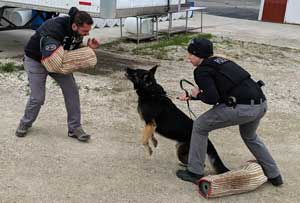
For anyone wanting to get into the K-9 handling profession, it is important to learn everything about K-9s, their behaviors, and the responsibilities that come with being a K-9 handler. Although you do receive training in terms of handling your canine partner, you must not hesitate to go the extra mile to learn as much as you can on your own.
It is also paramount to learn about “decoying.” Decoys are used when training a dog for apprehension and bit work. It is important for handlers to have good decoys that can train their dogs to bite and release in a proper manner. People who are interested in K-9 handling are always encouraged to become a good decoy. This is because good decoys can read dogs in a way that an average person cannot.
Is also important for a K-9 handler to cultivate people skills and work on their ability to communicate well. This is because interacting with the community forms a good amount of what these officers do. In addition to that, being a K-9 handler becomes very rewarding when you have a good interaction with your community. People love dogs and even if they can’t pet a canine, a dog never fails to bring a smile on their faces.
Being a K-9 handler is one of the most rewarding law enforcement jobs there is. A K-9 handler gets to bring their best friend to work each day. The dog always accompanies them on walks, calls, or trails. Having a big K-9 with you at work always comes with a heightened sense of security.
More About K-9 Bane and the K-9 Squad Car
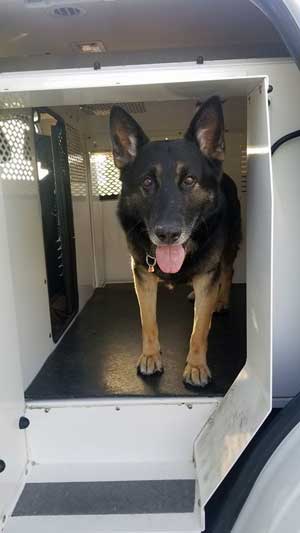
He loves to be in a squad and drive around. He loves to come to work. Bane won’t let his handler leave the house unless he gets to go with her. Alongside being great at work, he is also a great house dog.
A black and tan German Shepherd, Bane is 100% purebred and is dual-purpose trained in apprehension and narcotic work. However, his main skills lie in tracking and finding people.
Bane is 80 pounds, but when you look at him, you’d think he’s quite small for a shepherd. He’s extremely stocky but overall, he’s a strong, solid, and very intelligent dog, especially when it comes to police work.
Bane’s Facebook page is how he has pretty much become a local media sensation. He’s been in most local papers and local news channels too. His Facebook page, K-9 Bane has about 5,000 followers from across the world.
K-9 Bane has a squad that’s specifically designed for a K-9 with a cage in back. The squad has a heat alarm so that the K-9 handler can monitor the temperature level inside the car using a cell phone. If the temperature gets too hot, the K-9 handler is notified as well as a supervisor. The squad car also has a feature so that the K-9 handler can push a button on a device worn around their neck or on their belt and the back door on the squad pops up to let the K-9 come out to their handler.
The Best Job in Law Enforcement
So when you are looking at police jobs near me to find police department hiring, in addition to finding out he police officer requirements for each agency, consider if the agency have a K-9 unit, what are the police officer requirements. Of all of the law enforcement careers out there, being a K-9 handler is one of the best police department jobs.
According to Detective McManus, “Having been a K-9 handler for the last six plus years, is by far the best job in law enforcement. It has been the most rewarding opportunity that this agency could have given me. And even though I’ve chosen not to take the next dog, it will be the highlight of my career. I get to bring my best friend with me every day to work. If I’m at work, he’s at work. He has yet to miss a day at work.”

 Joseph Libowsky,
Joseph Libowsky,